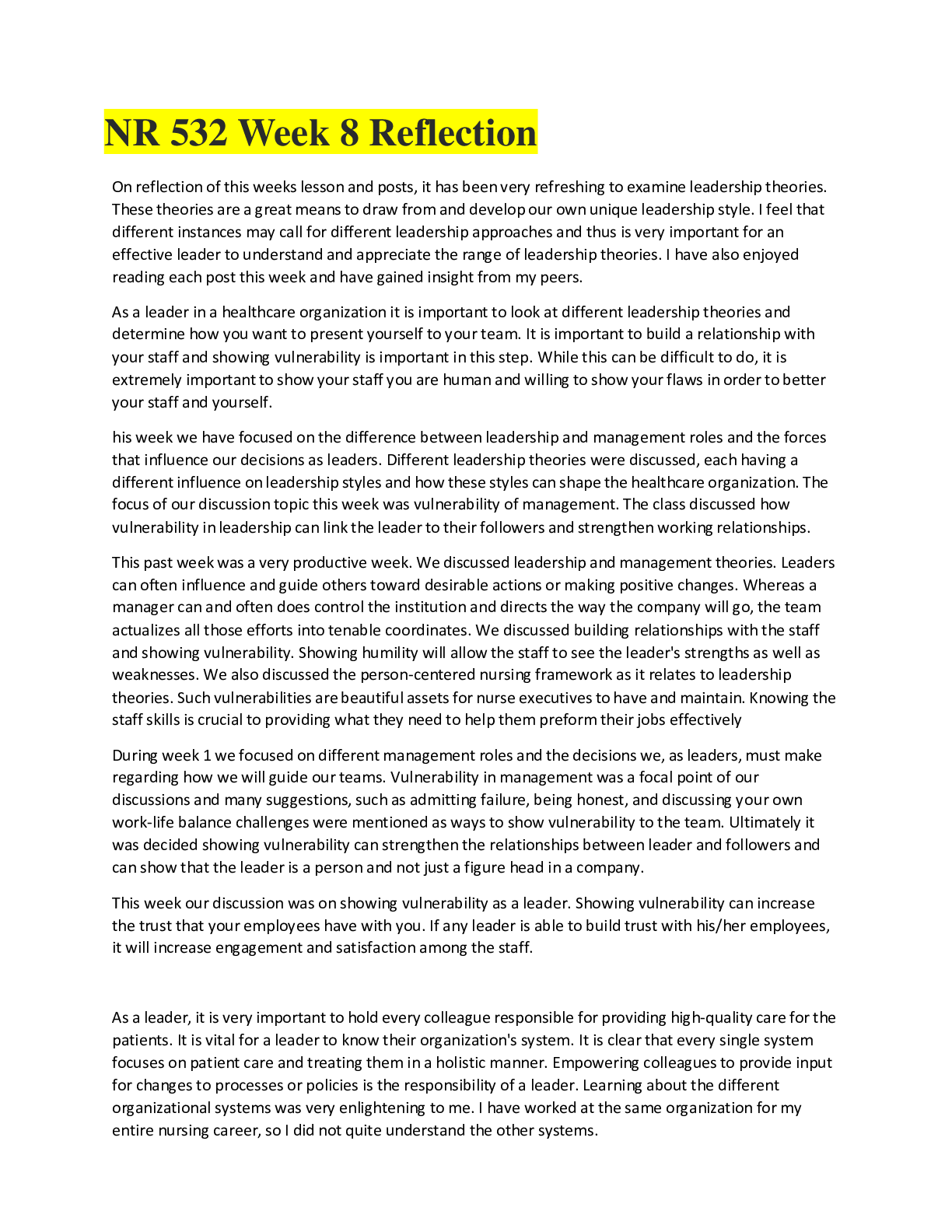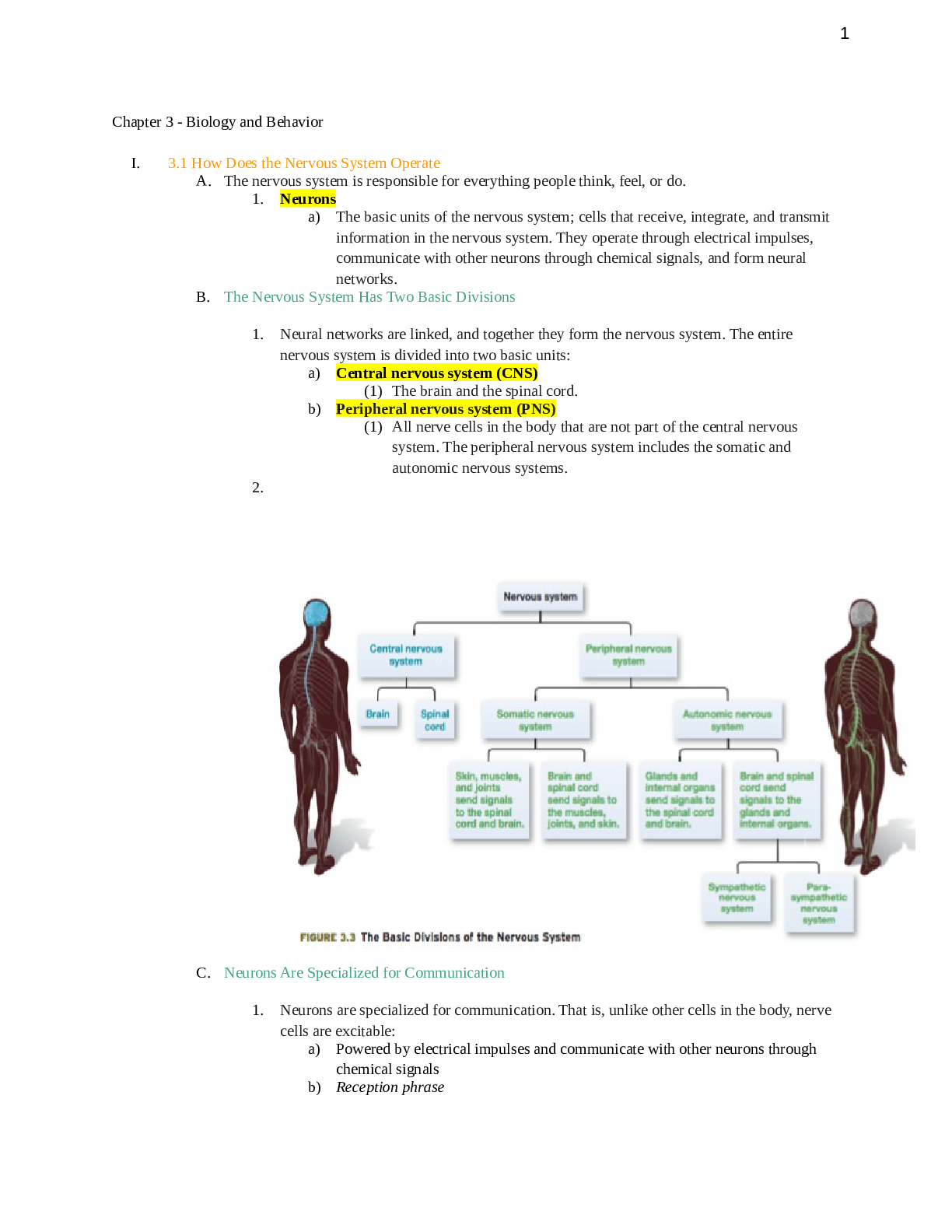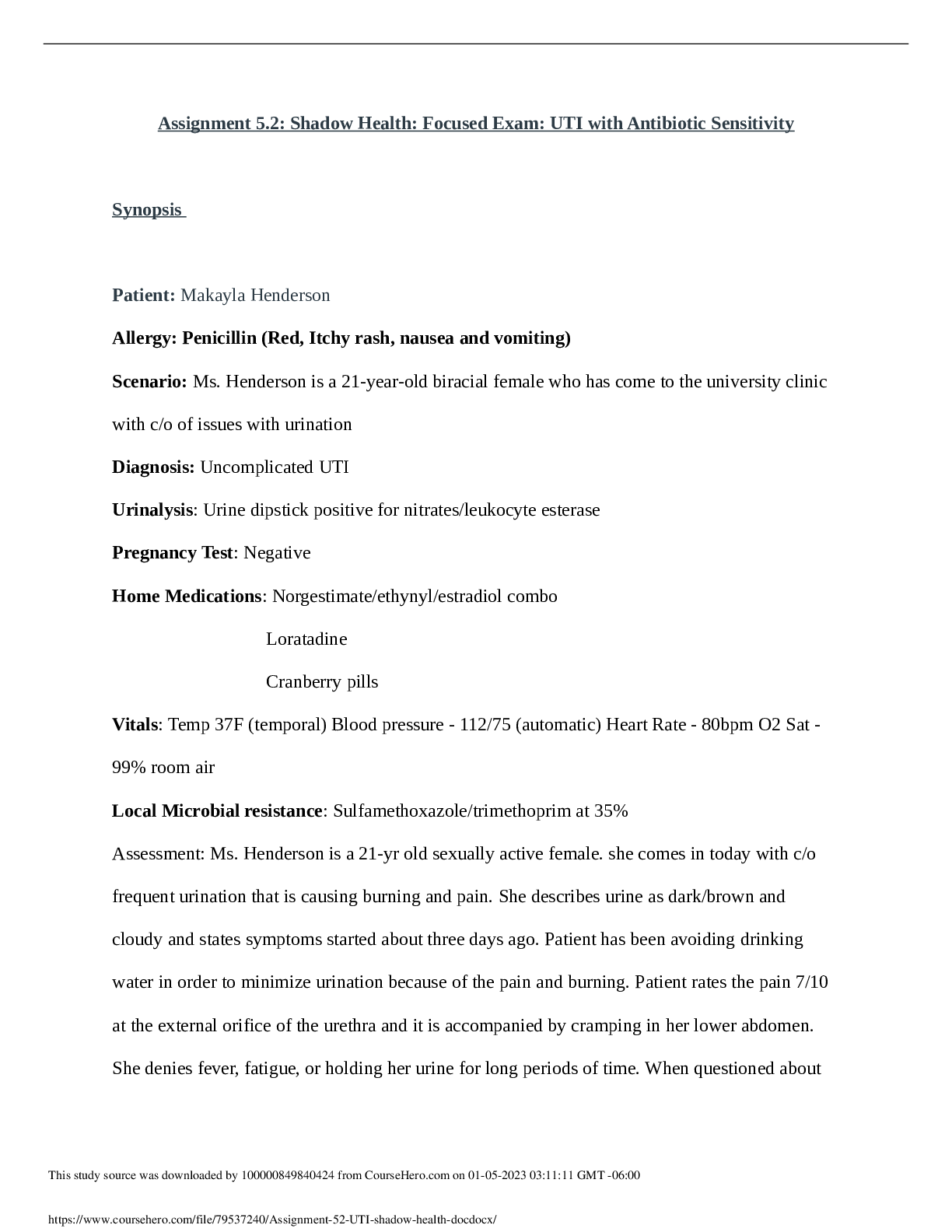NURS 464 ATI Pharmacology Remediation 2 | Download To Score An A.
Document Content and Description Below
ATI Pharmacology Remediation 2.ATI Pharmacology Remediation 2. Adverse Effects, Interactions, and Contraindications: Using an Epinephrine Auto- Injector Ch 5 p. 36 Question asked about client... teaching for epinephrine auto-injector and I chose do not massage site after injection Answer was probably can inject through clothes if necessary Anaphylactic Nursing Considerations: Treat with epinephrine, bronchodilators, and antihistamines. Provide respiratory support, and inform the provider Antibiotics Affecting the Bacterial Cell Wall: Priority Finding to Report to Provider Ch 44 p. 358 (I think the answer to this question was sensitivity or allergy to flax??) If indications of allergy appear (urticarial, rash, hypotension, dyspnea), stop administration immediately, and notify the provider. Question clients carefully about their history of allergy to a penicillin or other cephalosporin, and notify the provider if present. An allergy to corn or corn products and previous allergy to vancomycin are contraindications. Use cautiously for older adults and with clients who have renal impairment or hearing loss. Medications Affecting Coagulation: Contraindications for Antiplatelet Medications Ch 25 p. 192/ Parenteral anticoagulants are contraindicated in clients who have low platelet counts (thrombocytopenia) or uncontrollable bleeding. These medications should not be used during or following surgeries of the eye(s), brain, or spinal cord; lumbar puncture; or regional anesthesia. Use cautiously in clients who have hemophilia, increased capillary permeability, dissecting aneurysm, peptic ulcer disease, severe hypertension, hepatic or kidney disease, or threatened abortion. Classified as Pregnancy Risk Category X due to high risk of fetal hemorrhage, fetal death, and CNS defects. Heparin can be safely used if anticoagulation therapy during pregnancy is necessary. Peptic Ulcer Disease: Providing Medication Instructions Ch 28 p. 215, 216 Advise client to take amoxicillin, clarithromycin, and metronidazole with food to decrease gastric disturbances. Advise clients that adverse effects of nausea and diarrhea are common. Remind clients to take the full course of prescribed medications. Advise clients not to take an antacid 1 hr before or after taking a histamine 2- receptor antagonist. Ranitidine can be taken with or without food. Avoid smoking, which can delay healing. Avoid NSAIDs unless taking low-dose aspirin therapy for prevention of cardiovascular disease. Advise clients to avoid alcohol, which can exacerbate peptic ulcer disease. Medical Conditions: Monitoring a Client Receiving Magnesium Sulfate for Preterm Labor Ch 9 (Did not match my ATI book, Ch 9 is Bipolar Disorders) Ch 32 has a short excerpt on Magnesium Sulfate p. 255, p. 61 for Ch 9 ATI provided during focus assessment Magnesium sulfate: Mediation of choice for prophylaxis or treatment to depress the CNS and prevent seizures in the client who has eclampsia and severe preeclampsia. Monitor for signs of magnesium sulfate toxicity (Multiple answer!): Absence of patellar deep tendon reflexes (this was a choice), Urine output less than 30 mL/hr (one choice was 80 mL in 4 hours), Respirations less than 12/min, decreased level of consciousness (this was a choice, I think I missed this one!), and cardiac dysrhythmias. Mycobacterial, Fungal, and Parasitic Infections: Monitoring Usage of Rifampin Ch 47 p. 376 Rifampin is given in combination with at least one other antituberculosis medication to help prevent antibiotic resistance. Monitor liver function. Depending on therapeutic intent, effectiveness is evidenced by the following: improvement of tuberculosis manifestations, such as clear breath sounds, no night sweats, increased appetite, and no afternoon rises of temperature and three negative sputum cultures for tuberculosis, usually taking 3-6 months to achieve. Endocrine Disorders: Identifying a Need for a Dosage Increase of Levothyroxine Ch 40 p. 316 Multiple Answer!!! Depending on therapeutic intent, evidence of effectiveness can include the following: Decreased TSH levels, T4 levels within expected reference range, Absence of hypothyroidism manifestations (depression, weight gain, bradycardia, anorexia, cold intolerance, dry skin, menorrhagia). Depressive Disorders: Client Education About MAOIs Ch 8 p. 58/59 Question was client teaching for foods to avoid with phenelzine (Tyramine-rich foods!) Options were: Cream cheese, smoked salmon, and two others that were not considerable. I chose cream cheese, but answer was smoked salmon!!! Tyramine-rich foods include: aged cheese, pepperoni, salami, avocados, figs, bananas, smoked fish, protein dietary supplements, soups, soy sauce, some beers, and red wine. Vitamins, Minerals, and Supplements: Administration of Iron Supplement Ch 30 Question was administering ferrous fumarate to an infant (I said mix with a little applesauce) but it was more priority to rinse mouth out after giving. Instruct to clients to take on an empty stomach, such as 1 hr before meals, as stomach acid increases absorption. Instruct clients to take with food if GI adverse effects occur. Inform clients to dilute liquid iron with water or juice, drink with a straw, and rinse the mouth after swallowing. Airflow Disorders: Teaching About Cromolyn Ch 17 Couldn’t find in the chapter… Cromolyn is a mast cell stabilizer, two options were: Cromolyn takes effect in about 15 minutes (I chose this one) or to use after exercise (but should be before…) Advise clients to take medication 15 minutes before exercise or exposure to allergen. Advise clients that long-term prophylaxis may take several weeks before full therapeutic effect is established. Advise clients that this is not a bronchodilator and is not intended for use during an asthmatic attack. Instruct clients in the proper use of administration devises (nebulizer, MDI). Take sips of water before and after to reduce unpleasant taste. Pharmacokinetics and Routes of Administration: Parenteral Medications Ch 1 p. 7 Question was which medication would you expect to administer parenterally. Options were: -statin, -ine, and another medication, but I chose furosemide. It was probably the fourth option. Vastus lateralis is best for infants 1 year and younger. The ventrogluteal site is preferable for IM injections and for injecting volumes exceeding 2 mL. For IV administration, immediately monitor clients for therapeutic and adverse effects. Bone Disorders: Instruction for Taking Biphophonates Ch 34 p. 273 Alendronate!! I think it was what to monitor or what was not expected.. Tablets are prescribed once daily or once a week The liquid form is prescribed once a week. Monitor bone density. Clients should have a bone density scan every 12-18 months. Monitor serum calcium. Expected reference range is 9-10.5 mg/dL. [Show More]
Last updated: 1 year ago
Preview 1 out of 3 pages
Instant download

Buy this document to get the full access instantly
Instant Download Access after purchase
Add to cartInstant download
Reviews( 0 )
Document information
Connected school, study & course
About the document
Uploaded On
Dec 03, 2021
Number of pages
3
Written in
Additional information
This document has been written for:
Uploaded
Dec 03, 2021
Downloads
0
Views
81






 (1).png)
 (1).png)




